"Bounty always recieves part of its value from the manner in which it is bestowed"—Samuel Johnson
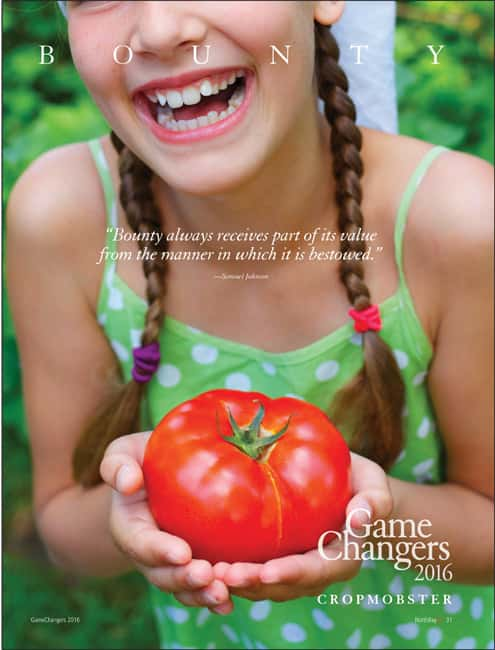 Three years ago in early March, Nick Papadopoulos was working as general manager for the family farm, Bloomfield Organics in Petaluma, when he and his wife, Jessica Flood, noticed seven boxes of produce in the vegetable cooler. It was a Sunday evening and the produce had been returned unsold from three farmers markets. There was roughly $600 of organic-certified kale, cauliflower, broccoli, radishes, chard, romaine and more, stacked in a corner, unsold and uneaten.
Three years ago in early March, Nick Papadopoulos was working as general manager for the family farm, Bloomfield Organics in Petaluma, when he and his wife, Jessica Flood, noticed seven boxes of produce in the vegetable cooler. It was a Sunday evening and the produce had been returned unsold from three farmers markets. There was roughly $600 of organic-certified kale, cauliflower, broccoli, radishes, chard, romaine and more, stacked in a corner, unsold and uneaten.
“Here was premium, award-winning food that my family put love and investment into, and it was going to waste. We weren’t selling it and we didn’t have time to locate a hunger relief organization to pick it up,” recalls Papadopoulos (who’s first to admit that wasted of any kind—especially food—ignites an “insane anger” inside of him). About 40 percent of our food is going to waste in our country, he explains, meanwhile one in six Americans are struggling with food insecurity.
Instead of feeding this produce to the chickens, which was the usual routine at Bloomfield Organics, the couple discussed what to do. “We wanted it to go to people who could use it,” Flood recalls. Solution-oriented Papadopoulos took charge. At seven o’clock that evening, he posted the following alert on Bloomfield Organics’ Facebook page: “BLOOMFIELD ORGANICS FOOD SECURITY EXPERIMENT¾FLASH MOB FRIDGE GLEANING! Please read and share.”
With a click, he posted the message, thinking it was no more than a simple experiment to find out if he could get this ultra-premium food into the mouths of hungry, budget-conscious people and recover some of the money they’d invested in the effort to grow it. “We weren’t trying to save the world, we just wanted to ask the community to get involved and transform a very specific situation of loss into a win-win for our farm and the community at large,” says 40-year-old Papadopoulos. “This was an experiment to deal with a situation.”
An hour-and-a-half later, the farm struck a deal with Megan Sweeley of the Harvest Park subdivision in Santa Rosa. Sweeley used Facebook to round up eight or so families to each pitch in $20 and the deal was done. “We created value from loss and the food found hungry homes,” Papadopoulos says. What’s more, this seemingly small random act had a beneficial outcome. Bloomfield Organics recouped some of its limited farming dollars, eight Sonoma County families got a deal on premium organic produce and a lasting relationship was forged between Bloomfield Organics and the Harvest Park neighborhood. “It was straight-up fun and such a heart-warming experience for everyone involved,” says Papadopoulos.
The chickens lost out that day (they were still fed), but that exchange was the humble beginning of a new professional path for the husband-wife team.
Flash mob, crop mob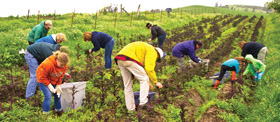
Following the successful experiment, an idea took root for the couple in the days that followed. If they could either sell, glean, donate or trade this food that might have been fed to the chickens, wouldn’t this work again? “We were excited to see where this could go,” says Flood.
“We immediately saw the opportunity to improve sales as well as make more efficient donations to hunger relievers and food gleaners,” adds Papadopoulos. “It wasn’t just about making money but about making it easier to recover food that would be wasted and try to get our community to wake up and change the mindset that somehow it’s OK that food goes to waste.”
Playing off the term “flash mob” (coined in 2003), they tried names like Food System Flash Mobs. “Someone called it a ‘crop mob,’ and that was it¾CropMobster,” Papadopoulos recalls. Over a weekend, he partnered with Sebastopol’s Gary Cedar of Press Tree to build the online marketplace, CropMobster.com, to boost impact and sharing in the local food system. The website officially launched on March 24, 2013, and received widespread praise and immediate response from farmers, consumers, health advocates and policy makers. “We launched this idea of crowdsourcing and, with community support, raised the barn,” he says. Within a few weeks, other local farms, hunger relief organizations and gleaning groups got involved.”
Meanwhile, a reporter who’d driven by the farm and saw the Bloomfield Organics sign called, wanting to write a piece for The California Report (a statewide radio news program). She saw a posting Papadopoulos wrote about their experiment on Bloomfield Organics’ website and included it in her report. Suddenly, CropMobster was receiving statewide attention.
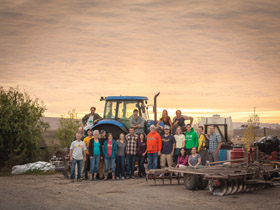 A family mission
A family mission
Food, agriculture and finding useful purposes for potentially wasted items are values both Papadopoulos and Flood grew up with. “My dad was a dumpster diver,” Papadopoulos says of his father, Michael, a world-class mathematician and social activist. By the time young Nick was eight years old, he and his sister, Kate, taken numerous dumpster diving adventures with his dad to feed the chickens they raised for eggs—and sometimes to feed the family as well. Both his father and mother, Janis, were teachers and activists who instilled in Nick the importance of taking action when he encountered problems.
Jessica grew up in a farming family; her mother and stepfather, Karen and Michael Collins, operated Bloomfield Organics in Petaluma for 13 years. Though the farm closed earlier this year, Michael has been a leader in sustainable farming and agricultural innovation for more than 30 years, a cause he’s still involved with today.
Nick and Jessica met while attending Santa Rosa Junior College (SRJC). A mutual friend, David “Coppertop” Pucket, was terminally ill, receiving care from hospice and friends who were helping out. The couple met when their shifts crossed, and they slowly became friends. They began carpooling to school and later grew flowers and vegetables together for farmers markets. Once the couple moved on from SRJC, Papadopoulos went on to study at Sonoma State University; Flood traveled to Mexico and began an award-winning career as an event designer.
“One of my first jobs was to help Mike Collins [Jessica’s stepfather] at Sonoma Permaculture,” says Papadopoulos. “What I learned there changed my way of looking at the world by showing me how things can integrate to function better, whether at the home landscape level or a community organization level.”
Papadopoulos next met John Garn, a leading sustainability expert, and helped him start ViewCraft, a consultancy using systems mapping tools to help community leaders untangle complex natural resource and policy programs. He also worked with for Pat Roney Vintage Wine Estates to start wine brands to raise funds for important causes. Later, Papadopoulos began working at Collaborative Consulting and helped manage a program called Transform (a business boot camp of sorts), for major nonprofits and corporations. He continues to serve as a senior advisor today. Papadopoulos maintains contact with all of his former employers and partners, and credits them in helping CropMobster grow and improve.
As for Nick and Jessica’s personal relationship, it blossomed along the way and they married in 2004. Says Jessica, “Our relationship is our bedrock.”
The early days of CropMobster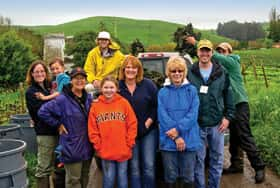
Once CropMobster officially launched online, there was an avalanche of local and statewide media attention. TV and radio host Larry King singled out CropMobster in his Huffington Post blog, and CropMobster received coverage from TIME as well as Central Chinese TV. In the months that followed, CropMobster began receiving requests from individuals and organizations in all 50 states, as well as other countries, asking for help starting similar programs in their area. CropMobster was gaining momentum and helping unleash a movement for change.
The attention was welcome, says Papadopoulos, but sometimes it was too much. “It created a lot of demand and interest we weren’t prepared to meet as a young start-up,” he says. There were requests from communities around the world as well as major venture capital firms. Their work skyrocketed from trying to find a hungry home for extra bunches of kale and figuring out how to keep the bills paid, to unexpected worldwide renown.
CropMobster SF Bay (and now, CropMobster Sacramento) gained support in the form of key advertising sponsorships. Chris Call, chief executive officer of Grange Credit Union, for example, was the first to boldly jump in to sponsor the San Francisco Bay CropMobster and help keep the exchange open for the entire community. Says Call, “We saw a close alignment between CropMobster’s mission and our own mission of serving the agricultural community of the Bay Area. Our credit union was founded by farmers and has a seven decades-long history of helping people involved in agriculture. CropMobster brings the technological revolution down home to the farm and creates a virtual farmers market and community exchange that directly benefits our customers.”
What kind of impact has CropMobster had on the Bay Area? “CropMobster facilitates efficient use of agricultural products and helps minimize waste,” says Call. “It’s a way of getting supply into the hands of those who have a demand. It’s changing the supply chain system of agriculture.”
CropMobster’s revenue model in the Bay Area (its homegrown exchange) is funded by advertising sponsors such as the Grange Credit Union and One Day Labs. To launch CropMobster in new counties or regions, there’s typically a lead organization that funds the initial start-up; Papadopoulos calls it an “impact franchise” model. For instance, Valley Vision, a regional leadership organization based in Sacramento, partnered with CropMobster to launch CropMobster Sacramento with start-up funding from Bank of America and The Walmart Foundation.
CropMobster also caught the attention of community leaders including Sonoma County Supervisor James Gore (a former USDA official in the Obama Administration), who sees CropMobster as creating a virtual food hub with numerous streams of community benefit. “People around the county have been trying to promote food hubs with minimal success,” says Gore. “CropMobster has successfully harnessed the power of the virtual economy and brought it into real life with impact.”
According to Gore, CropMobster has converted thousands of pounds of food waste into value. For example, fish carcasses at Bodega Bay that normally went to landfill are now creating fertilizer; and farmers market leftovers are going to hungry homes. As for his own personal experience, Gore (who has eight fruit trees in his yard) once posted an alert on CropMobster for the excess fruit. As a result, the Healdsburg Food Pantry came to his home and picked 600 pounds of oranges that were then delivered to the local Boys & Girls Club. “I use CropMobster every year so the fruit doesn’t go to waste,” says Gore. “This is something we all need to use more.”
Today, CropMobster is developing additional tools to further its mission. “[CropMobster] has an offering that helps community leaders start their own local food network or exchange,” says Papadopoulos. “It’s a sort of hyper-local Craigslist for food and agriculture, but operated by trained local ‘impact facilitators’ whose job is to help address specific issues important to a local movement, economy or community. To be impactful, alliances and partnerships with existing organizations are key. As an example, organizations such as Slow Food, Farm Trails and Petaluma Bounty have embraced CropMobster in the interest of making food systems work better. We work as an integrator or connector between a range of organizations and topics in food systems.”
Recent postings on the “Alert” page of its website read: “Sliding scale farm stand opening in Petaluma;” “30 bags of Himalayan salt¾20 percent off”; and “40,000 pounds of Organic Hemp Seed Meal and Chia Seeds available.” But the CropMobster exchange is full of possibilities. In April, Sonic, a Bay Area telecom firm based in Santa Rosa, posted an alert hoping to gain the attention of artists, woodworkers and designers. It wanted to unload large wooden spools (or wheels), because it was driving them “bonkers” spending time and energy dismantling them.
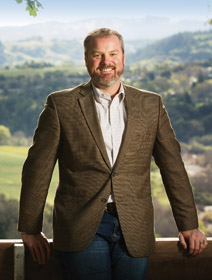 The CropMobster impact
The CropMobster impact
Since CropMobster was founded three years ago, the organization continues to grow, both statewide and nationally. Papadopoulos serves as chief executive officer; Flood (now an award-winning events designer) works behind the scenes, creating CropMobster events and serving on the board of directors. Cole Geissinger (chief technology officer) and Crystal Millican (VP of Strategy & Operations) also play leading roles. CropMobsters’ mission is to partner with leaders to grow inspired local food networks to help communities prevent food waste, support hunger relievers and stimulate local food economies. “We provide more than a technology solution,” says Papadopoulos. “We provide what I like to call ‘CropMobster University,’ which helps train local leaders and youth to manage and run their own county or regional exchanges. We call these local leaders ‘food system DJs.’”
Papadopoulos concedes they’ve come a long way for a small team, “But when you look at what needs to be done, we have a long way to go. That fuels our mission with a deep sense of urgency,” he says.
What’s driving business these days? “After three years, we have an economically viable model and proof of concept. We not only connect the dots on food waste and hunger, but we’re becoming recognized as a true partner to community leaders, especially those in the next generation, who wants to do things differently,” says Papadopoulos. “Now we have a generation of leaders and youth who want new solutions that promote sharing and collaboration. Leaders in communities see [CropMobster] as a partner. We provide the technology as well as deep expertise and coaching on a range of topics. We’re as much a trainer and teacher as we are a Craigslist or Tinder.”
What’s more, Bill Foss, who’s deeply involved in sustainable agriculture and the co-founder of NetScape, has agreed to advise and mentor the project as it works to scale up, says Papadopoulos.
Since CropMobster was founded, the impact of its work has been both hugely productive and inspiring. “We lost track of our community’s impact after saving 2 million pounds of food and raising $2 million dollars for local farmers, hunger relievers and others who used our platform in the first 18 months,” says Papadopoulos. “One of our main projects now is to rebuild how our platform helps community members and sponsoring advertisers track and record impact, so we can all see the difference we’re making.”
Meanwhile, CropMobster’s mission and work continues to expand and reveal new streams of impact. Says Papadopoulos, “We’re connecting people to help each other out—it’s about helping yourself and helping others.” Through Sacramento CropMobster, for example, Valley Vision connected a juice company with a pig farmer. The juice company produces about 15 tons of fruit waste per day. For the cost of fuel and labor, the farmer is the recipient of high-quality feed, and the pigs happily munch on fruit remains.
The magic of CropMobster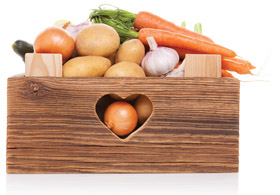
Since that fateful evening in the vegetable cooler three years ago, CropMobster’s impact continues to inspire others. What’s the key to its success? “The magic of CropMobster isn’t about our team or technology, but the values and the community members from all walks of life who trust us enough to engage with our vision,” says Papadopoulos. “We’ve found that when everyone gives a little, they receive twice in return.”
“CropMobster is one of those rare ‘game changers’ that creates a shift in the way markets work,” says Call. “The antiquated process farmers have used for centuries to get product to market is now being replaced with a highly efficient mechanism for producers to communicate with buyers. And at the same time, [CropMobster] is incorporating the added social benefit of diverting excess product from community landfills to community kitchens for those in need. It’s also raising awareness of what agriculture does for our community. Event postings and action alerts make it easy to see the wonderful impact agriculture has on our economy.”
Meanwhile, the husband-wife team continues to focus on the mission to empower communities with their own local food and sharing networks. “Food waste is still the heartbeat of our effort, but things have evolved to where folks are using us for many types of exchanges,” says Papadopoulos. “We’ve expanded into a wide range of uses beyond selling and supporting hunger relievers and serving as a hub for local food systems. We’re excited to have a growing social venture that equips leaders to solve true community needs and issues when it comes to food, agriculture and resources.”
Looking to the future, there’s still much work to be done. “I would love to see CropMobster grow across the United States and internationally,” says Flood. “CropMobster is a labor of love.”
Says Papadopoulos, “We want to provide tools and knowledge to community leaders¾especially youth¾to help them grow their own local exchanges and ignite their own impact in their communities. Our goal is to inspire a change in mindset and to provide gear and solutions people can use to make and impact—make magic happen.”
Did You Know?
America wastes roughly 40 percent of its food, which adds up to $165 billion per year, according to the National Resources Defense Council. And it’s wasted at every point along the food chain¾on farms and fishing boats, during processing and distribution, retail stores, restaurants and at home. What’s more, of the 133 billion pounds of food wasted, much of it is edible and nutritious.
Food for Thought
CropMobster is essentially a food network, enabling neighbor-to-neighbor sharing. Here are a few facts about food from CropMobster:
• One third of all food produced in the world is wasted and goes uneaten;
• Nearly 1 billion people in the world are hungry or experiencing food insecurity;
• If food waste were a country, it would be the third largest emitter of greenhouse gas emissions next to China and the United States;
• Many small farmers and food businesses do not make money and have a hard time gaining authentic, affordable exposure for their brands; and
• 28 percent of all agricultural land globally is used to produce food that’s wasted, leading to a corresponding waste of water, fertilizer and other precious natural resources.
Author
-

Karen Hart is the editor of NorthBay biz magazine, keeping her finger on the pulse of the North Bay, directing content and leading day-to-day operations of the editorial team. An award-winning writer, Karen brings more than 30 years of experience to the position. She is a member of the California Writers Club, and serves on the Journalism Advisory Council at Santa Rosa Junior College. She moved to Sonoma County in 2000, and she’s here to stay.
View all posts



